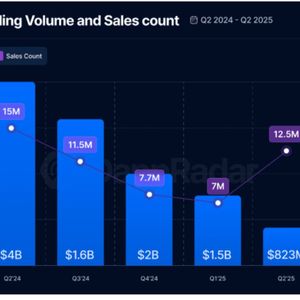White House Unveils Crucial Tariff Deadline Extension to August 1
8 min read
BitcoinWorld White House Unveils Crucial Tariff Deadline Extension to August 1 The economic landscape is constantly shifting, and few announcements capture attention quite like those impacting international trade. Recently, the White House delivered a significant update that has ripple effects across various sectors, including potentially influencing the broader sentiment in global markets. Get ready to dive into the details of a pivotal decision concerning the tariff deadline and what it means for businesses, consumers, and investors worldwide. Understanding the Extended Tariff Deadline: What’s Changing? In a move that provides a brief reprieve and perhaps an opportunity for further negotiations, White House Press Secretary Karoline Leavitt confirmed that U.S. President Donald Trump is set to sign an executive order (EO) today. This order will extend the existing tariff deadline from its original July schedule to August 1. The news, initially reported by the reliable Walter Bloomberg economic news account on X, has immediately become a focal point for economic analysts and market participants. But what does this extension truly signify? At its core, it means a few more weeks of certainty – or perhaps, continued anticipation – for industries heavily reliant on international trade. For businesses that import or export goods subject to these tariffs, an extended deadline offers: Additional Planning Time: Companies can adjust supply chains, re-evaluate sourcing strategies, and prepare for potential future changes with a slightly longer runway. Reduced Immediate Pressure: The immediate crunch to meet the July deadline is alleviated, preventing hasty decisions that could lead to inefficiencies or losses. Opportunity for Dialogue: It could signal an ongoing willingness for trade discussions and negotiations to continue, rather than an immediate imposition of new or increased tariffs. While a few weeks might not seem like a monumental shift, in the fast-paced world of global commerce, every day counts. It’s a pause, a moment to breathe, and potentially a sign of strategic maneuvering on the international stage. The Significance of a White House EO in Trade Policy When we talk about the White House EO , it’s important to understand the power and implications behind such an executive order. An Executive Order is a directive issued by the President of the United States that manages operations of the federal government. While not legislation passed by Congress, EOs carry the full force of law and are often used to implement or interpret statutes, constitutional provisions, or treaties. In the context of trade, a presidential executive order can swiftly alter policy, bypass lengthy legislative processes, and send clear signals to both domestic and international stakeholders. This particular EO regarding the tariff extension highlights the executive branch’s direct authority in shaping the nation’s trade posture. It demonstrates a presidential prerogative to manage economic pressures and diplomatic relations in real-time. Historically, presidents have used EOs to address various economic and trade matters. This specific action is not an isolated incident but rather a continuation of a broader approach to trade management that prioritizes flexibility and direct intervention when deemed necessary. The immediate impact of this White House EO is to delay the imposition of certain tariffs, offering a temporary reprieve and perhaps setting the stage for future negotiations or policy shifts. Recalling the Era of Donald Trump Tariffs: A Brief History The concept of tariffs gained significant prominence during Donald Trump’s previous presidential term. The administration frequently employed tariffs as a key tool in its trade arsenal, aiming to reshape global trade relationships and protect domestic industries. The overarching philosophy behind these Donald Trump tariffs was often centered on reducing trade deficits, bringing manufacturing jobs back to the U.S., and compelling trading partners to adhere to what the administration viewed as fairer trade practices. Key tariff actions during that period included: Steel and Aluminum Tariffs: Imposed broadly on imports from many countries, citing national security concerns. Tariffs on Chinese Goods: A wide range of products from China faced tariffs, leading to a prolonged trade war between the two economic giants. The stated goal was to address intellectual property theft and forced technology transfers. Threats of Tariffs on European Automobiles: Though largely not implemented, these threats aimed to pressure the European Union on various trade issues. These actions led to significant debate among economists and policymakers. Supporters argued they leveled the playing field for American businesses, while critics pointed to increased costs for consumers, retaliatory tariffs from other countries, and disruptions to global supply chains. The current extension of the tariff deadline is a direct echo of this past policy, indicating that trade tools remain a significant part of the current administration’s economic strategy. Navigating Complex Trade Policy in a Dynamic World The decision to extend the trade policy deadline underscores the intricate and often delicate nature of international commerce. Modern trade policy is far more than just setting tariffs; it involves a complex web of agreements, diplomatic relations, and economic strategies designed to balance national interests with global economic stability. This extension could be interpreted in several ways: A Strategic Pause: It might provide more time for the U.S. to negotiate with specific countries or blocs, aiming for more favorable terms before making a definitive move on tariffs. Economic Data Review: The administration might be waiting for more economic data to assess the potential impact of new tariffs on inflation, consumer spending, or specific industries. Domestic Political Considerations: In an election year, every economic decision is scrutinized. Delaying a potentially disruptive tariff imposition could be a politically calculated move. The challenges in modern trade policy are numerous. Supply chains are increasingly globalized, meaning tariffs in one area can have unforeseen ripple effects across multiple industries and countries. Furthermore, retaliatory tariffs from affected nations can harm American exporters, creating a tit-for-tat scenario that ultimately hurts global growth. Here’s a simplified look at the potential challenges and benefits: Aspect Potential Challenges Potential Benefits (of Extension) Businesses Ongoing uncertainty, difficulty in long-term planning, potential cost increases. More time to adjust supply chains, reduced immediate financial burden, opportunity for lobbying. Consumers Potential for higher prices if tariffs are eventually imposed, reduced product variety. Delay in potential price increases, continued access to current product ranges. Global Relations Risk of retaliatory measures, strained diplomatic ties. Opportunity for continued negotiation, potential for de-escalation of trade tensions. Analyzing the Ripple Effects on Global Markets Any significant announcement concerning trade, especially from a major economic power like the United States, inevitably sends ripples through global markets . Investors, traders, and businesses worldwide pay close attention to such developments, as they can influence everything from stock prices and commodity values to currency exchange rates. The extension of the tariff deadline could evoke a mixed reaction in markets: Initial Relief: For sectors heavily exposed to tariffs, such as manufacturing, automotive, and technology, the delay might be met with a sigh of relief, potentially leading to a short-term positive sentiment in related stock indices. Continued Uncertainty: While the immediate threat is postponed, the underlying issue of tariffs remains unresolved. This prolonged uncertainty can prevent significant long-term investment decisions and keep market volatility elevated. Currency Fluctuations: The U.S. dollar’s strength or weakness can be influenced by trade policy. An extension might lead to minor adjustments as traders reassess the likelihood of future trade agreements or disputes. Commodity Prices: Tariffs on raw materials or agricultural products can directly impact their global prices. A delay might stabilize prices in the short term, but the long-term outlook remains tied to the August 1 decision. For those interested in cryptocurrencies, while not directly impacted by tariffs, the broader sentiment in global markets can subtly influence digital asset prices. When traditional markets experience uncertainty or instability due to macroeconomic factors like trade wars, some investors might seek safe havens, which can sometimes include cryptocurrencies like Bitcoin. Conversely, a stable and predictable economic environment might reduce the perceived urgency of alternative investments. Thus, understanding these macro-level shifts is crucial for any market participant. What Happens Next? The Road to August 1 and Beyond The period leading up to August 1 will be critical. It’s a window for diplomacy, negotiation, and economic assessment. While the specific reasons for choosing August 1 are not explicitly stated, it provides a defined endpoint for this temporary extension. What could unfold in the coming weeks? Intensified Negotiations: We might see a flurry of diplomatic activity as the U.S. engages with key trading partners to resolve outstanding issues. Economic Data Analysis: The administration will likely be closely monitoring inflation rates, employment figures, and manufacturing data to gauge the health of the U.S. economy and the potential impact of future tariff actions. Public and Industry Input: Businesses and industry groups will likely continue to lobby the White House, presenting their cases for or against the imposition of tariffs. Beyond August 1, several scenarios are possible: Tariffs Imposed: The tariffs could be fully implemented as initially planned. Further Extension: Another extension could be granted if progress is being made in negotiations or if economic conditions warrant it. Tariffs Modified: The tariffs could be adjusted in scope, rate, or target, reflecting partial agreements or new strategies. Tariffs Withdrawn: In the event of a comprehensive agreement, some or all of the tariffs could be withdrawn. The uncertainty inherent in these possibilities means that businesses and investors must remain agile and informed, preparing for various outcomes. Actionable Insights for Businesses and Investors Given the ongoing fluidity of trade policy, what steps can individuals and organizations take? Stay Informed: Continuously monitor official White House announcements, economic news, and analyses from reputable sources. Reliable information is your best defense against market volatility. Assess Your Exposure: Businesses should conduct thorough assessments of their supply chains and customer bases to understand their direct and indirect exposure to tariffs. Diversification of suppliers and markets can mitigate risks. Scenario Planning: Develop contingency plans for different outcomes post-August 1. What if tariffs are imposed? What if they’re extended again? Having a plan for each scenario can save time and resources. Engage with Industry Groups: Participate in industry associations that lobby policymakers. Collective voices can have a greater impact on trade decisions. Review Investment Portfolios: Investors should consider the potential impact of trade policy on different asset classes. While direct links to crypto are nuanced, overall market stability affects sentiment across the board. Conclusion: A Critical Watch on Trade Developments The White House’s decision to extend the tariff deadline to August 1 is a significant development that offers a temporary pause in the ongoing saga of global trade relations. While it provides a brief respite for industries and markets, it also underscores the continued uncertainty surrounding international commerce. The legacy of Donald Trump tariffs and the broader complexities of trade policy continue to shape the outlook for global markets . All eyes will now be on the developments leading up to the new deadline, as stakeholders await clarity on the future of these crucial economic levers. Staying informed and adaptable will be key for navigating these dynamic times. To learn more about the latest global economic trends , explore our article on key developments shaping international trade policies and their impact on future market stability. This post White House Unveils Crucial Tariff Deadline Extension to August 1 first appeared on BitcoinWorld and is written by Editorial Team

Source: Bitcoin World



